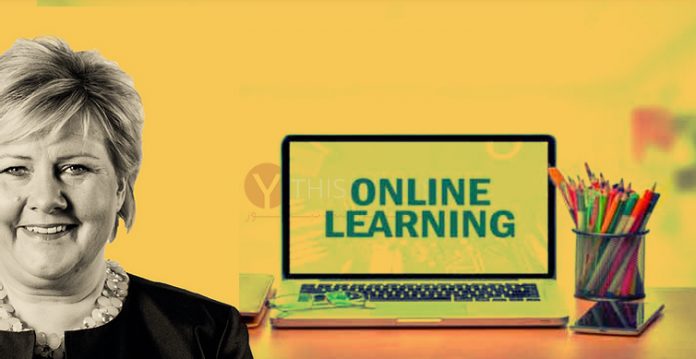With the coronavirus pandemic forcing students to learn from home through virtual classes, Norway’s Prime Minister and the Minister of Research are looking at ways to continue the education medium even after the covid times.
“I would like to learn more programming,” Prime Minister Erna Solberg (H) was quoted by news agency NTB.
Ms. Solberg said that she believes education could be a major boon for everyone and as for a well-established person like her, shifting to a new city to avail knowledge could be difficult, hence bringing into the picture the concept of learning from home because full-time school is not quite feasible.
In a bid to provide flexible learning systems to people over the nation, the Prime Minister and Minister of Research and Higher Education Henrik Asheim (H) are jointly working towards putting to implement a strategy that allows teaching to go digital completely with the decentralized study offers.
“It is not just the 19-year-old who is the future student. It is also the 40-year-old who chooses to build on what they already know,” Solberg said.
The Education and Research Minister haven’t himself completed his education and he says he looks at finishing it digitally whenever it becomes possible in the future. He added that universities and all educational institutions need to make their services available to all people, irrespective of what phase of life they are in.
“Through corona, we have actually learned a little. The universities and colleges quickly set up a number of new courses that could be combined with people who were actually in full-time jobs,” he said.
Mr. Asheim said he expects to witness more education mechanisms of such sort.
“The strategy is not a corona measure. It will gather the examples we have today and point forward to how education should be made available to people all over the country in different life situations,” he told NTB.
As part of the new planning, the government has reserved NOK 132 million in 2021’s state budget for promoting flexible learning systems.
The government has already set aside NOK 132 million to develop flexible education offers in this year’s state budget.
The strategy for the same will be presented before summer and will contain the methods to be followed in the future years.
The work surrounding the matter will kickstart following both the ministers’ visit to all universities and colleges and a discussion with them on Tuesday at the annual contact conference.
“The situation for today’s students, with too much digital teaching during the pandemic, will not be permanent. But for many adults, who need extra education or want to get a new one, it is probably a better offer to follow along digitally than to move to a city,” the Minister of Research and Higher Education said.
Apart from this, it also showcases their plan to begin distance education for the complete bachelor’s and master’s degree programs in order to allow young students to access education from any part of the nation.
“If you are in a life situation that makes it difficult, then you can get decentralized education. We just have to take that into account,” Solberg said.
This is being labeled as democratization by the PM.
“It makes higher education available to far more people than today. There are a number of people who, precisely because of their life situation or for financial reasons, cannot take an entire year off or travel and be somewhere else,” she said.
“It is not the case that everything should be in Oslo. On the contrary, I believe that this provides an opportunity to expand the number of students elsewhere. You can have an institution in Tromsø that provides education to the people of Kristiansand. The good professional environments get more legs to stand on when they can deliver an offer to the whole country,” she further added.
“They must adapt to the needs of the whole society, and not just be aimed at the full-time student of 20 years of age,” Asheim noted.







